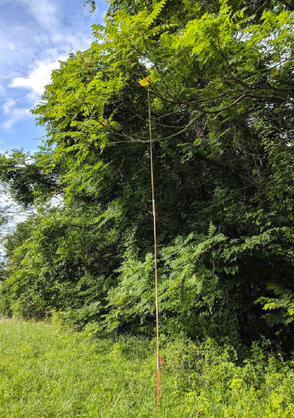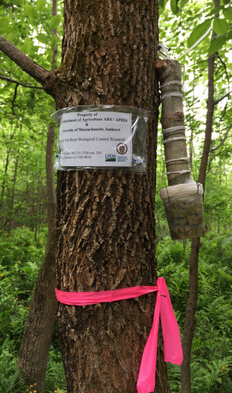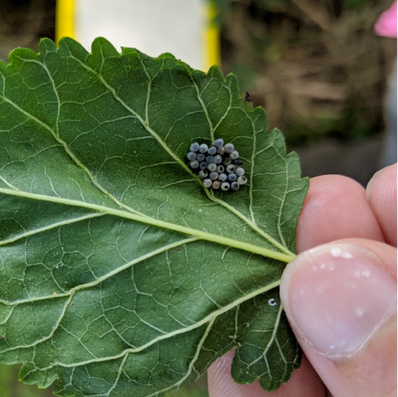|
written by: Max Ferlauto and Madeline Potter Most tiny insects go unnoticed, yet tiny insects can greatly impact humans and our ecosystems. Dr. Nicole Quinn has spent the past five years researching how to utilize particularly tiny insects, known as parasitic wasps, to help manage invasive insect pests (non-native species that cause harm). The invasive pests Dr. Quinn focused on were the brown marmorated stink bug (Halyomorpha halys) during her PhD research at Virginia Tech University, and the emerald ash borer (Agrilus planipennis) during her postdoctoral research with USDA-ARS Beneficial Insects Introduction Research Unit and University of Massachusetts. Her research helps reveal and enhance methods to effectively control invasive insects. As a part of her PhD research, Dr. Quinn studied the foraging ecology and sampling of the parasitic wasp, Trissolcus japonicus, and its host the brown marmorated stink bug (BMSB). BMSB is native to Northeast Asia but was introduced to the U.S. in the late 1990s. Since then, BMSB has spread to 47 U.S. States, feeding on a wide range of host plants. Trissolcus japonicus is a parasitic wasp that parasitizes BMSB eggs in BMSB’s native region. Trissolcus japonicus was accidentally introduced to the U.S. in 2015 and has now spread to 13 U.S. States.
 Figure 2. A yellow stick card atop a 4.8-meter poll in a tree of heaven’s canopy. Figure 2. A yellow stick card atop a 4.8-meter poll in a tree of heaven’s canopy. Dr. Quinn successfully collected T. japonicus in the middle tree canopy, using the tall poles topped with a yellow sticky card. Using this survey technique, Dr. Quinn was able to determine that habitat type does not affect T. japonicus capture and determine that host plants do not affect T. japonicus capture. From these findings, Dr. Quinn shows scientific support for the use of yellow sticky cards to monitor T. japonicus in the field (Quinn et al. 2019 a, b; Quinn et al. 2021). She was also able to elucidate the foraging ecology of T. japonicus, informing future studies on T. japonicus’s impact on native insects (Quinn et al. 2021). In 2002, shiny green beetles were found killing Ash trees in Michigan. Specimens were quickly sent to the Michigan State Entomology Department and then to beetle experts around the world (Poland & McCullough, 2006). Soon the beetle was identified as the Emerald Ash Borer (EAB), a wood-boring beetle native to East Asia. After surveys, the prospects for Ash trees in North America were grim, but nevertheless, hopeful quarantines and firewood regulations were put in place. Unfortunately, over the past 20 years, EAB has proven difficult to control. Now, the last hope to control EAB populations relies on tiny insects no larger than your pinky nail. Spathius galinae and Tetrastichus planipennisi, parasitoid wasp species native to many of the same regions as EAB, were introduced to the U.S. as biocontrol agents to combat EAB. However, once released, little is known about the effectiveness of these species. Therefore, Dr. Quinn’s research specifically studies their dispersal and phenology to assess their efficacy as biocontrol agents.  Figure 3. Sentinel logs used to monitor parasitoids. Figure 3. Sentinel logs used to monitor parasitoids. First, Dr. Quinn used sentinel logs (Figure 3) to check for signs of parasitism across increasing distances from where parasitoids were released in 2015- 2017. She reared EAB larvae in the lab and then inserted them into grooves in a wooden log. The logs were then hung from infected ash trees in two-kilometer intervals up to 14 kilometers away. She collected and replaced the logs every two weeks for eight weeks. The logs then were reared in the lab and emerging parasitoids were counted. Dr. Quinn found that both S. galinae and T. planipennisi were found at least 14 kilometers away from release sites, the farthest points from the release sites sampled. Dr. Quinn also used a debarking monitoring technique at each release site to determine how many EAB larvae were alive or parasitized. She cut down pole-sized ash trees, removed their bark, and recorded the number of EAB larvae parasitized. In New York, she found that 14% of EAB larvae were parasitized and 67% of those parasitized larvae were killed by S. galinae. This meant that the phenology of the biocontrol wasps matched that of the EAB larvae. Dr. Quinn’s EAB research shows that parasitic wasp populations have spread from release sites and are parasitizing EAB larvae at least three years after release dates. More research is needed to understand if parasitism is reducing EAB populations, but recent work by other scientists in the field (such as Duan et al, 2021) looks promising. Parasitic wasps may indeed be limiting EAB populations. Tiny but mighty parasitic wasps may save us from invasive insects thanks to Dr. Quinn’s research and research by other entomologists. The next time you see a tiny, winged insect on a plant or insect egg, take a second look and you may spot a parasitic wasp. Dr. Quinn’s research in the field of biological control has led to an assistant professorship at the University of Florida where she will be conducting research and teaching. What pest insect will Dr. Quinn study next?
Authors Max Ferlauto is a third year PhD student in Karin Burghardt’s lab studying the effects of suburban leaf litter management on overwintering ecology. Madeline Potter is a second year Master’s student in the Shrewsbury lab researching the biology and ecology of Anastatus reduvii, a North American native parasitoid to control Halyomorpha halys. Citations Duan, J. J., Van Driesche, R. G., Schmude, J., Crandall, R., Rutlege, C., Quinn, N., ... & Elkinton, J. S. (2021). Significant suppression of invasive emerald ash borer by introduced parasitoids: potential for North American ash recovery. Journal of Pest Science, 1-10. Quinn, N. F., Gould, J. S., Rutledge, C. E., Fassler, A., Elkinton, J. S., & Duan, J. J. (2022). Spread and phenology of Spathius galinae and Tetrastichus planipennisi, recently introduced for biocontrol of emerald ash borer (Coleoptera: Buprestidae) in the northeastern United States. Biological Control, 165, 104794. Quinn, N. F., Talamas, E. J., Acebes-Doria, A. L., Leskey, T. C., Bergh, J. C., (2019a). Vertical sampling in tree canopies for Halyomorpha halys (Hemiptera: Pentatomidae) life stages and its egg parasitoid, Trissolcus japonicus (Hymenoptera: Scelionidae). Environmental Entomology, 48, 173–180. Quinn, N. F., Talamas, E. J., Leskey, T. C., Bergh, J. C., (2019b). Sampling methods for adventive Trissolcus japonicus (Hymenoptera: Scelionidae) in a wild tree host of Halyomorpha halys (Hemiptera: Pentatomidae). Journal of Economic Entomology, 112, 1997–2000. Quinn, N.F., Talamas, E. J., Leskey, T. C., Bergh, J. C., (2021). Seasonal captures of Trissolcus japonicus (Ashmead) (Hymenoptera: Scelionidae) and the effects of habitat type and tree species on detection frequency. Insects, 12, 118. Poland, T. M., & McCullough, D. G. (2006). Emerald ash borer: invasion of the urban forest and the threat to North America’s ash resource. Journal of Forestry, 104(3), 118-124. Comments are closed.
|
Categories
All
Archives
June 2024
|
Department of Entomology
University of Maryland
4112 Plant Sciences Building
College Park, MD 20742-4454
USA
Telephone: 301.405.3911
Fax: 301.314.9290
University of Maryland
4112 Plant Sciences Building
College Park, MD 20742-4454
USA
Telephone: 301.405.3911
Fax: 301.314.9290


 RSS Feed
RSS Feed




